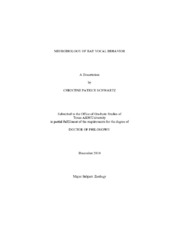| dc.description.abstract | Vocal plasticity is presumed to be a key element underlying the evolution of human
speech and language, but the mechanisms and neuroanatomical basis for this plasticity
remain largely unknown. The Mexican free-tailed bat, Tadarida brasiliensis, presents a
unique opportunity to advance our understanding of the evolution and neurobiology of
mammalian vocal communication because this animal displays elements of vocal
complexity and plasticity that are more sophisticated than any mammal other than
humans, including non-human primates. Current models of vocal control in mammals
do not account for the vocal complexity of free-tailed bats. The purpose of this
dissertation is to fill that gap in knowledge by identifying a possible neuronal basis for
vocal complexity in free-tailed bats. This will be achieved by 1) providing a detailed
analysis of the free-tailed bat’s vocal behaviors, 2) mapping the distribution of
neurotransmitter receptor types suspected of involvement in vocal control, 3) identifying
brain regions that exhibit increased neuronal activity during vocalizing, and 4)
pharmacologically manipulating putative vocal control regions to confirm and
characterize their function in vocalizing.
Analysis of Tadarida’s vocal behavior indicated that they have a vast vocal
repertoire, including many different call types, context-dependent sensory-feedback
driven vocal plasticity, and syntactically-organized stereotyped songs. Their vocal
behavior changed seasonally, so I mapped the distribution of melatonin binding sites in
the brain, finding high densities in the striatum, similar to dopamine receptor
distribution. I then used immunohistochemical labeling of the immediate early gene cfos
to map neuronal activation in brains of highly vocal bats to find ROIs activated by
vocal production. This technique not only identified all previously known regions of the
mammalian vocal motor pathway but also revealed activity in novel brain regions that
could potentially account for vocal plasticity, including a localized region of the basal
ganglia, the dorsolateral caudate nucleus, and the anterior cingulate region of the frontal
cortex. Pharmacological excitation of these regions evoked complex vocal sequences
similar to the songs recorded in the field and lab. These results support the hypothesis
that the mammalian basal ganglia may play a crucial role in the plasticity and
complexity of mammalian vocal behaviors. | en |


